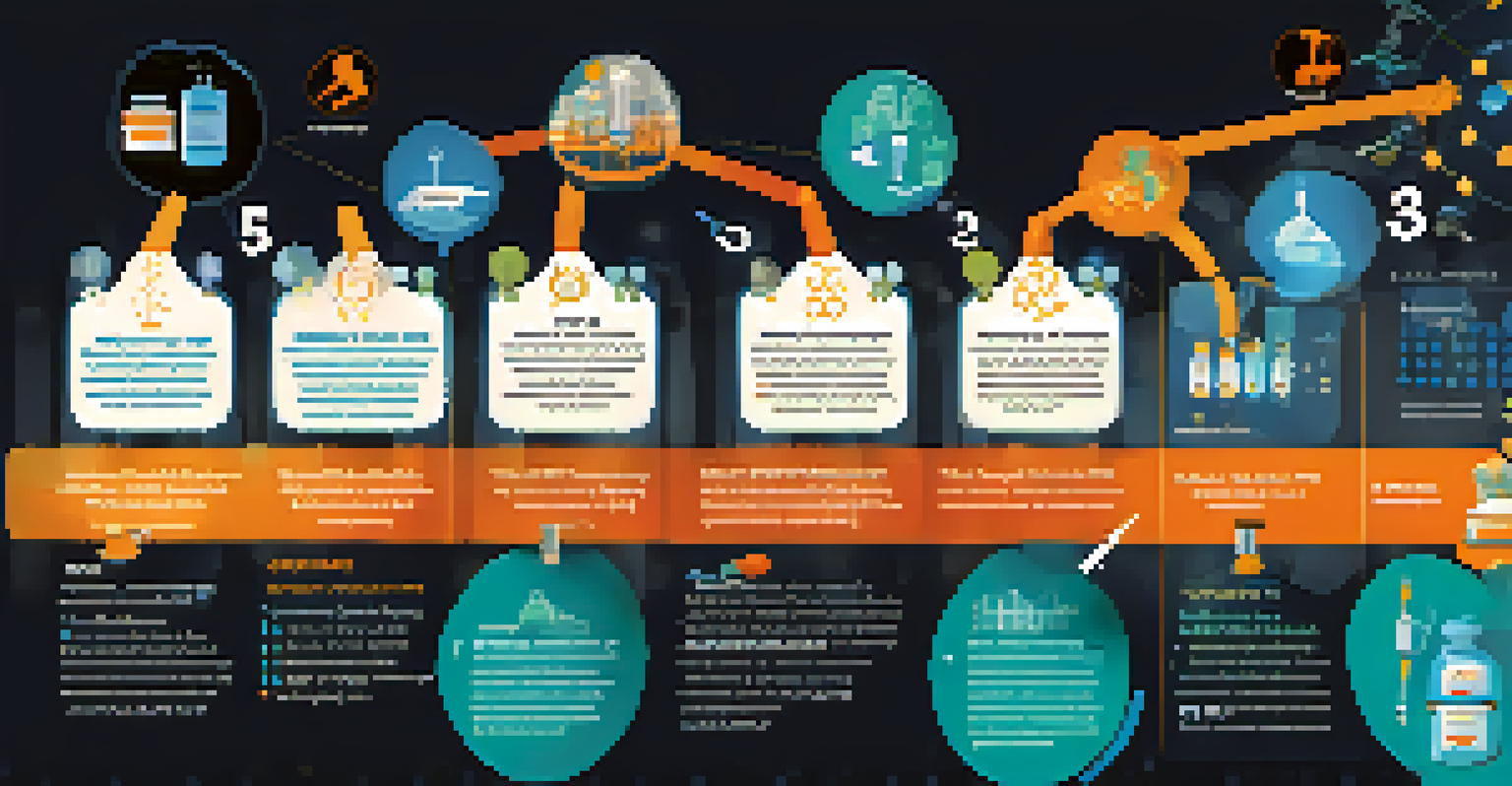How mRNA Technology Revolutionizes Vaccine Development Today

Understanding mRNA Technology: The Basics
Messenger RNA (mRNA) is a type of genetic material that instructs cells to produce proteins. Unlike traditional vaccines that often use weakened or inactivated viruses, mRNA vaccines teach our bodies to recognize and combat pathogens by utilizing our own cellular machinery. This cutting-edge technology was pioneered in research labs but has become a household name during the COVID-19 pandemic.
The greatest weapon against stress is our ability to choose one thought over another.
The simplicity of mRNA vaccines allows for quicker development times. Instead of needing to grow large quantities of virus, scientists can synthesize mRNA in the lab, which significantly speeds up the production process. This agility is crucial, especially during outbreaks or pandemics when time is of the essence.
Moreover, mRNA vaccines can be easily updated. If a virus mutates, researchers can quickly modify the mRNA sequence to target the new strain, a flexibility that traditional vaccines struggle to match. This adaptability makes mRNA technology an invaluable tool in the ongoing battle against infectious diseases.
The Role of mRNA Vaccines in the COVID-19 Pandemic
The COVID-19 pandemic brought mRNA vaccines into the spotlight, with Pfizer-BioNTech and Moderna leading the charge. These vaccines were developed and authorized for emergency use in record time, showcasing the potential of mRNA technology. This rapid response not only saved countless lives but also transformed public perception of vaccine development.

The success of these mRNA vaccines has highlighted their effectiveness, with studies showing high efficacy rates in preventing severe illness. This effectiveness has instilled confidence in the public and encouraged more people to get vaccinated. The speed and success of these vaccines have set a new standard for how vaccines can be developed in the future.
mRNA Vaccines Revolutionize Health
mRNA technology has transformed vaccine development, enabling rapid and effective responses to infectious diseases like COVID-19.
Additionally, the global collaboration seen during this pandemic has paved the way for future mRNA vaccine research. Scientists, governments, and organizations worked together to share data and resources, demonstrating that rapid innovation is possible when the world unites for a common cause.
Advantages of mRNA Vaccines Over Traditional Methods
One of the key advantages of mRNA vaccines is their safety profile. Since they do not contain live virus particles, there is no risk of causing the disease they aim to prevent. This aspect reassures individuals who may be hesitant about traditional vaccines that use live or weakened pathogens.
Innovation distinguishes between a leader and a follower.
Moreover, mRNA vaccines can elicit a robust immune response. They stimulate both the antibody response and the T-cell response, which is essential for long-lasting immunity. This dual action enhances our body’s ability to fight off infections, providing a comprehensive defense.
Lastly, the manufacturing process of mRNA vaccines is more straightforward and scalable compared to traditional vaccines. This means that in the event of a future outbreak, countries can produce and distribute vaccines more efficiently, ensuring that vaccines reach those in need quickly.
Challenges and Limitations of mRNA Technology
Despite their advantages, mRNA vaccines are not without challenges. One significant hurdle is their storage requirements; many mRNA vaccines need to be kept at ultra-low temperatures, complicating distribution logistics. This can be particularly problematic in regions with limited cold chain infrastructure.
Additionally, while mRNA vaccines have been shown to be effective, their long-term effects are still being studied. Understanding how long immunity lasts and whether booster shots will be necessary are ongoing areas of research. These uncertainties can lead to questions and hesitance among the public.
Global Health Equity is Crucial
Ensuring access to mRNA vaccines for all countries is essential to combat infectious diseases and promote global health equity.
Lastly, there's also the challenge of misinformation surrounding vaccines in general. As we have seen during the COVID-19 pandemic, misinformation can lead to vaccine hesitancy. It’s essential for public health officials to provide clear, accurate information to mitigate these concerns and encourage vaccination.
The Future of mRNA Vaccines Beyond COVID-19
The success of mRNA technology during the COVID-19 pandemic has opened doors for its use in other diseases. Researchers are now exploring mRNA vaccines for a variety of illnesses, including influenza, Zika virus, and even cancer. This expansion could revolutionize how we approach vaccine development for many diseases.
For instance, mRNA technology has the potential to create personalized cancer vaccines. By tailoring vaccines to target specific cancer cells in an individual, scientists hope to improve treatment outcomes. This could mark a significant advancement in how we treat cancer, shifting from traditional methods to more personalized approaches.
Additionally, the rise of mRNA technology could lead to the development of universal vaccines, which would offer broader protection against various strains of a virus. This innovation could greatly reduce the frequency of seasonal vaccinations and provide a more effective way to manage viral outbreaks.
mRNA Technology and Global Health Equity
As mRNA technology continues to evolve, it raises important questions about global health equity. Ensuring that all countries have access to these innovative vaccines is crucial in the fight against infectious diseases. The goal is to avoid a situation where only wealthy nations benefit from advancements in vaccine technology.
Global collaborations and initiatives, such as COVAX, aim to facilitate equitable distribution of vaccines worldwide. By working together, nations can ensure that mRNA vaccines reach underserved populations, helping to protect everyone, regardless of geography or income level.
Future Applications Expand Horizons
The success of mRNA vaccines paves the way for innovative treatments against various diseases, including cancer and influenza.
Moreover, investing in local manufacturing capabilities in low- and middle-income countries can further enhance global health equity. By building infrastructure and training local scientists, these countries can produce their own mRNA vaccines, promoting self-sufficiency and resilience in public health.
Conclusion: The Promise of mRNA Vaccine Technology
In conclusion, mRNA technology has revolutionized vaccine development, particularly highlighted by its role in combating COVID-19. Its ability to be developed quickly, safely, and effectively sets a new benchmark for future vaccines. By understanding its potential and limitations, we can better appreciate its impact on global health.
As we continue to explore the possibilities of mRNA vaccines, the health landscape is likely to change dramatically in the coming years. From personalized cancer treatments to universal vaccines, the future looks promising for mRNA technology.

Ultimately, the advancements in mRNA technology remind us of the importance of innovation in science. With continued research and collaboration, we can harness this technology to improve health outcomes worldwide and protect against emerging diseases.